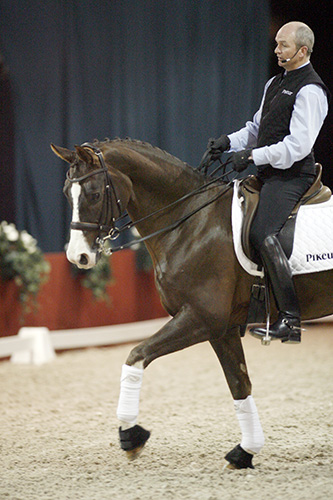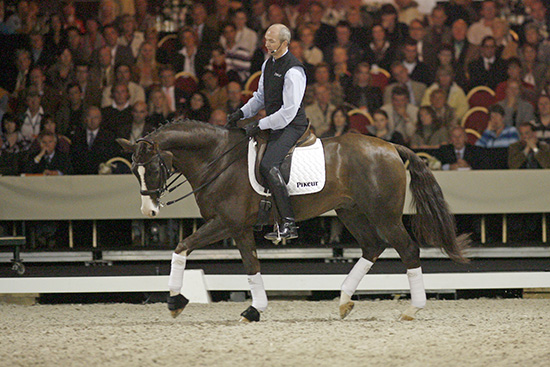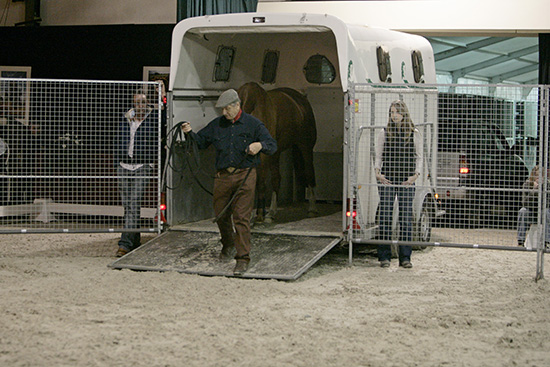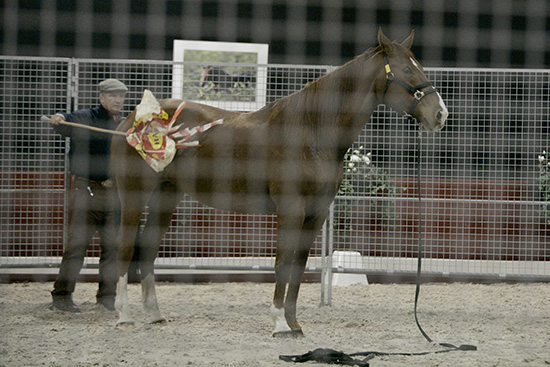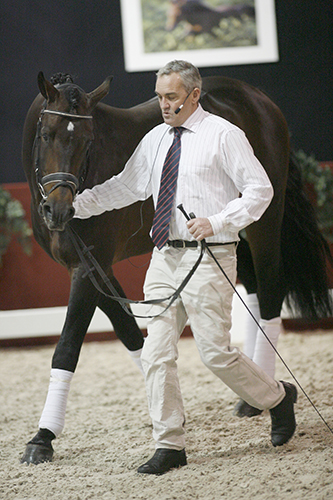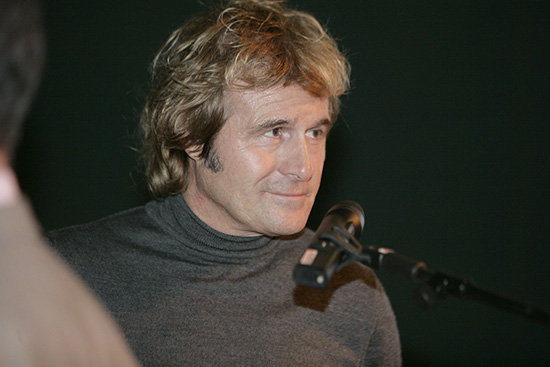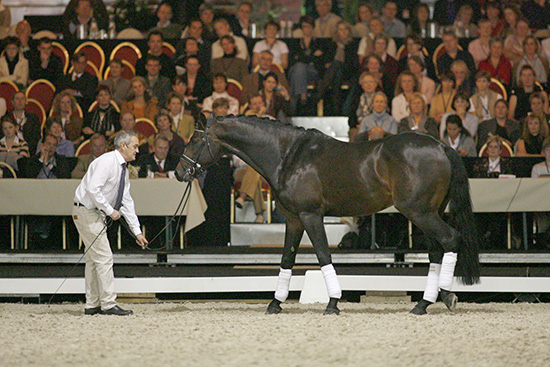 Andrew Mclean reports & Dirk Caremans took the photos…
Andrew Mclean reports & Dirk Caremans took the photos…
The setting for the 2006 Global dressage Forum at the Academy Bartels in Hooge Mierde, Holland was breathtaking. A workable yet beautifully appointed equestrian academy was transformed into a quality congress centre. Doormen, red carpet entrance, copious floral arrangements and chandeliers drooping overhead in the arena itself set the scene. The seating for the 400 delegates at one end of the arena faced a large theatre curtain that could be drawn to expose the pristine white sand arena behind. For each presentation, four panellists were seated at a white cloth table adjacent to the stage and for the two days of the forum the delegates were lavishly catered for.
No amount of opulence however could do full justice to the emerging importance of the GDF: The only world-class focal point where everything dressage ranging from welfare to technical aspects, is open for discussion, examination and debate and where judges and other officials can come face to face with the public. In a sport where welfare aspects are implicit and one that has its roots in the culture, interpretation and aesthetics of the Renaissance, the forum is imperative for development.
The GDF is the brainchild of Dr Joep Bartels, arguably one of the most innovative and driven visionaries in the contemporary dressage scene. It was Joep who foresaw and materialised the Kür in the modern competition setting despite hard-headed opposition from dressage fundamentalists at the time. Now of course the vindication of his vision is self-evident: the Kür is hauling dressage from synchronised-swimming status to astonishing public popularity.
The chairman of the International Trainers’ club, David Hunt opened the forum remarking on the success of the WEG this year where three different horses won the classes and he emphasised the healthy significance that that they were not all trained by the same training system. Questioning came from the panel of four, however the real line of questioning began with persistent and incisive prompting by Richard Davison, one of the sharpest knives in the dressage drawer and an articulate host.
At times he steered the forum against the wind sufficient only to avoid capsize in a remarkable way so that all critical questions, reservations and viewpoints were dragged from the murky depths of private mutterings and given a full airing.
It is a shame that the FEI does not come on board, as there are so many serious issues ranging from welfare to judging that need airing in a forum such as the GDF. A number of judges led by Mariette Withages and Stephen Clarke showed by their participation, their commendable eagerness for dialogue, transparency and development.
This year the scope of the GDF was widened to include more profound aspects of equine ethology and learning and included a presentation and demonstration by Monty Roberts.
The diverse agenda began with Hubertus Schmidt, who described and demonstrated on Fabio the methods he uses to produce such a prolific number of Grand Prix horses.
It was the perfect way to begin the forum. Fabio was indeed a beautiful picture, looking elastic and never shortening his neck during transitions, always appearing loose and free of tension. Hubertus is an unassuming master of his trade, and he emphasised the importance of looseness in the beginning of every work session and as a base for all further work. Without it, there can be no quality training but increasing resistance all the way through to the higher levels. Swing and development of cadence rely on the basic template of looseness. Hubertus emphasised that if the rider should release the reins for more than two strides, the properly trained horse should stretch and seek the contact.
Like so many people of great talent, he made things simple for the horse and ensured that the horse learns to go on its own without constant signals from the rider. What is most remarkable about this man is that because of his still and perfectly balanced position, his aids can of course be more invisible and subtle than most because the horse ‘hears’ everything that his aids suggest – there is none of the ‘background noise’ of inadvertent messages that accompanies poorer positions, no ambiguous messages from his aids.
A change of pace followed Hubertus’ demonstration with a fully interactive discussion regarding the judging at the WEG, led by the Dressage Committee Chairman, Mariette Withages and assisting on the panel were Stephen Clarke and David Hunt. On a huge electronic drop-down screen before the eyes of the audience appeared, by DVD three of the Grand Prix tests of the WEG: Andreas Helgstrand & Blue Hors Matine, Isabell Werth & Satchmo, and Bernadette Pujals & Vincent.
The DVD simultaneously showed each combination performing every marked movement of the test – the immediate comparison made easy experts of the audience. The delegates were asked for their opinions on the marks issued for each combination.
For the WEG judges on the panel it was looking down the barrel of a gun because not only are varied opinions inevitable and sometimes tainted by nationalism but the convenience of the DVD comparison and playback gives grand-stand judging a particular piety. Nevertheless the panel handled the discussions convincingly and showed not only their depth of knowledge but it also gave them the opportunity to emphasise the various big-picture criteria that surround judging decisions.
The DVD presentation if anything vindicated the quality of judging at the WEG although big discussions arose about Brentina’s high scores in spite of her apparent lameness.
Some of the German press noted that Matine’s piaffe and passage wasn’t elastic enough, but it was very expressive and the horse, in Stephen Clarke’s words, was smiling and appeared to be happy to do the work: remarkable especially considering her young age.
Dr Rico Shuijers, an eminent Dutch sports psychologist was invited again this year to the GDF following the popularity of his presentation last year. Nobody could be at all surprised about that: he is the most engaging presenter imaginable and constantly interacts with the audience. He had us all trying to do impossible things simultaneously with hands and legs to show how we are hard-wired to move in certain ways.
He went on to describe how we, as competitors are our own worst enemies in the way we frequently set ourselves up for failure. He demonstrated the importance of trying to create the perfect mental state and the use of correct breathing and imagery.
Dr Shuijers showed also that when you are trying to achieve a set goal, it is unhelpful to think of the goal, because that impression has too much subjective emotional loading. Instead he showed with the help of Dutch Dressage team member, Laurens van Lieren, that it is far more beneficial to visualise the action itself – in other words to remember the successful performance and then visualise the parts of the body that provided the action for that success. Laurens had to throw coins into a hat and his performance certainly escalated when he stopped thinking about the hat and instead thought about the flow of action from his shoulders through to his arm that gave him success.
Dr Shuijers also was very disparaging of the negative and degrading methods of coaching that are rife enough in the equestrian world. While abuse may be reinforcing for the abuser, there are no benefits for the abused and performance can crash, sometimes irrevocably.
The first day of the forum concluded with a mixture of Hollywood and horse whispering. Monty Roberts arrived in a way that no other presenter had hitherto attempted. Persuasive music, video of wild horses and the story of his life with horses that was spiced up by his claims of childhood abuse (70 fractures before seven years of age) and pictures of his father and other horseman doing some rather horrific ‘training’ that wouldn’t be out of place in many of the rougher breaker’s yards today. One video clip of an unknown trainer featured a horse tethered short with one leg tied up and thrashing itself about till it dropped hung on the lead. The point was to illustrate by comparison his more welfare-friendly approach and there is no doubt that it did just that. I must admit though, I’m never comfortable hearing someone denigrate their parents in front of large crowds no matter how bad their folks were. It seems to me like one of those things you just don’t do….. maybe his father had his side of the story to tell too. Hard to say, but for me it detracted from the skills that this man has to offer.
I was on the panel of four for Monty’s presentation and after his oral presentation the curtains parted and in came a leisure horse that had a problem in loading into the float. A round-pen was set up and for the first few minutes, Monty taught it some groundwork and he emphasised the importance of in-hand work and especially training the horse to step backwards. He said he found it difficult to imagine why equestrian people don’t practise this and other aspects of obedient groundwork. I couldn’t agree more. I’ve seen a lot of in-hand work and I would have to say that Monty’s in-hand work is exceptional. His timing is perfect. He trained stop and go through step-back and lead forward so thoroughly that I knew that horse would go on the float now. But he wasn’t going to try to load it at this point, instead he was going to join-up with it.
I’m not a fan of join-up if it involves the horse experiencing fear: scooting around hollow and wide-eyed. It is an established fact that horses and other animals make impossible-to-forget associations between the chaser and their running that make future tension more likely to escalate than diminish. However, if driving a horse in long reins or lunging a horse or doing join-up involves no significantly raised tension levels, then there would hardly be damage.
In this case, Monty chased the horse throwing his lunge line at it, but the horse wasn’t running away, it was doing the bare minimum. He lunged the horse over a narrow tarpaulin to train it go places where it was reluctant to go and then had his rider ride the horse over the tarp.
He then expertly desensitised it to a plastic bag on a stick by removing it the instant the animal showed immobility. After all this, the horse loaded on to the float without a problem although he did use a part of the round pen as a race to prevent any sideways movement of the horse, a feature that some delegates felt was not practical.
I couldn’t help feeling that the join-up wasn’t necessary in any case as I felt the horse would have loaded after his in-hand work.
During the round-pen work, Monty chased the horse away and in doing so, made gestures at it with his hands and fingers simulating the claws of a cat. His interpretation of this was that the horse had an innate fear reaction to such postures. This seemed a bit fanciful as horses are unmoved by the gesture in my experience. A more likely explanation was that the horse could learn to react to such gestures if they occur in association with running away.
However what I queried most was the language he and other New Age trainers use to explain their interactions with horses. Monty believes that during his interactions with the horse, some kind of negotiations are happening and he emphasised the role of body language, leadership and dominance.
What I see happening that more fully explains what is going on is – conditioning. Join-up is the text-book example of negative reinforcement, along the same lines as the way we train horses to go from the legs or stop from the reins. Whilst the horse runs, pressure is applied (chasing / psychological pressure in Monty’s example), so that he learns that running is futile and this pressure is immediately removed when the horse shows slowing and ultimately, approaching.
My question to Monty centred on this as it seems to me more enlightening and educating to pupils if they learned the actual learning mechanisms (i.e. the timing of what they do) than to think about dominance styles or trying to emulate a lion by assuming a cat’s claws gesture with their hands.
In all situations, Monty was nothing short of genial and courteous. He constantly and humbly explained that he was at the GDF as much as to learn. When asked what he would like to see changed in dressage for welfare reasons, (I was thinking he’d say whips, spurs and curbs) he said piaffe, in his opinion, seemed to be the most stressful issue. In many ways, it was as much the unexpected that made the GDF so interesting.
The following day began with my presentation about the powerful toolbox that is provided by learning theory and that has not been fully exploited by dressage for maximum efficiency or to reduce problems. I began with the explanation of horse/human differences in mental processing that have implications for our expectations. Particular regions of the brain (parts of the prefrontal cortex) are unique to humans and primates, and it is important to break down training into single learned responses for efficiency.
To achieve optimal responding, we need to prioritise operantly conditioned responses of the horse’s limbs (his mobility) both in-hand as well as under-saddle before we attempt to alter the head/neck position in both the young horse and in the re-training situation.
For example, under saddle we should train the horse’s legs to precisely respond to the rider’s reins and legs. It is important to be exacting as to how we use pressure-release because it is mistakes in this that directly cause most behaviour problems. Horsemen frequently aim to reinforce the horse’s head position while the animal’s legs are taking control of speed and direction.
The next priority in training is to rapidly shrink these pressures into the lightest versions and then finally to transform them to other cues such as seat and weight etc. I described how training can be accelerated if you use an error-free format and follow precisely the principles provided by learning theory. I then went on to explain how training can go wrong, and how problems can occur through bad training, inadvertent bad experiences and poor riding.
The worst psychological effects of bad training and riding occur when the horse is trapped between relentless curb and spur. These effects range from conflict behaviours to chronic stress to learned helplessness and finally wastage (abattoirs). We need to recognise these conditions and suspect our training style when telltale signs such as conflict behaviours occur, or when colic shows up or when the horse becomes switched-off, dull and slow to learn new things because of learned helplessness. We have to be far better at blaming ourselves.
Because recent controlled studies show that the only things that judges cannot reliably determine is lightness I again suggested (as I did in Lausanne in January) that more tests of Überstreichen be introduced to dressage tests where rider’s demonstrate with a release of the reins for a maximum of two strides that the horse is comfortable to remain in the outline as well as the tempo and straightness. (I don’t mean releasing the reins for greater than two strides because in that case the horse naturally stretches his neck longer – that is another technique useful in other contexts).
In a dressage test it is essential to demonstrate the true essence of training – the formation of learned rather then ‘held’ responses. Überstreichen is the only way to accurately assess lightness, and I believe that it will be the saving of the sport, sometime in the future, from the die-hard animal liberationists. We can prove that the horse is happy to do the job as a learned response, rather than as a forced response.
Into the arena was led a young stallion that was, in the words of the handlers, very ‘opinionated’ and quite tense. Its mobility was not under control of the aids. I wanted to show that his behaviour could be explained as mistakes and ambiguities in the training of stop and go responses. The conflict behaviour he showed would diminish as a result of the transformation of pressure-release responses to subtle invisible ones. I emphasised that if you recognise that your goal is to place the legs of the horse under perfect control of the reins (and under-saddle the rider’s legs) to the point where he will lengthen and shorten the stride immediately and from light aids, then the horse immediately will relax because his world is now predictable.
I couldn’t have asked for a better example and the colt learned to lead correctly, to lengthen and shorten his strides easily and to ‘park’ immobile and thus became very relaxed and attentive.
The forum concluded with the vexing issue of hyperflexion (Rollkur), with Anky and Sjef, accompanied by Dr Rene van Weeren, showing the detailed mechanisms behind their methods followed by a demonstration of these techniques with Anky riding Painted Black.
It is to the great credit of Anky and Sjef that they are always prepared to explain their training methods that the world knows as Rollkur, the FEI calls hyperflexion and that Anky and Sjef call LDR training (long, deep, round). Anky was in the middle stages of pregnancy and gave a display on Painted Black that showed their emphasis on gradually training the horse in various head positions.
Anky and Sjef follow very simple-to-digest principles that are good psychology. For example, they don’t apply simultaneous rein and leg aids in downward transitions. If you ask Anky what aids she uses to ride a corner she replies with an absurdly simple ‘I just turn with my rein’.
It occurred to me that from the viewpoint of total training success, whatever confusions arise from hyperflexion may be to some degree compensated by the consistently simple aids that characterise Sjef and Anky’s training to the extent where they are able to train hotter types of horses than the majority of contemporaries. Painted Black was certainly elastic, soft and energetic with excellent transitions and some piaffe and passage that showed big promise.
Dr van Weeren explained the results of his research in collaboration with a Swedish team where they investigated the biomechanical effects of five different head positions including hyperflexion. Their results indicated that hyperflexion did not compromise the horse’s movement and that it actually resulted in greater elasticity of the hind legs.
Many of the pictures and videos of hyperflexion in many instances show tight curbs, contorted necks and hollow loins. Unfortunately there are many bad examples of hyperflexion where less capable riders try to emulate the technique. That concern however, applies to all techniques. It is important to recognise that strong relentless pressures in any carriage have negative welfare implications for horses, and we should be just as critical of relentless rein pressure with short upright jammed and broken necks. Nevertheless, the issue of Salinero bolting at the WEG arose and critics suggested it was connected with hyperflexion.
Sjef and Anky defended by saying that Salinero was indeed a hot sensitive type and because of his hero status in Holland had been previously exposed to deafening applause in the past that had disturbed him and that the crowd at the WEG was enormous and for Salinero, overwhelming. Monty suggested that they play CD’s of applause but they replied that they had tried this and it did not sufficiently replicate the real life conditions of top competitions.
No one really knows yet how much of this carriage can be self-maintained by the horse but it is likely that there would surely be a certain degree of hyperflexion that could be self-maintained.
I think if Überstreichen was utilised to test it, where the horse was trained to maintain the amount of hyperflexion that is possible, much of the criticism would die off and the alleged training benefits of the technique would still be there.
It was sensible to have the level-headed Kyra Kyrklund on the panel. Kyra has produced a great number of Grand Prix horses and is admired around the world for the soft way her horses go. This year at the WEG her young horse Max was awarded ‘the happiest horse’ nomination, an important award. Richard Davison dryly asked her after Sjef and Anky’s presentation if she would now begin to incorporate hyperflexion in her training. She replied that she wouldn’t do it because she couldn’t see the point of it.
It was put to Anky that she would be just as great without hyperflexion, however Anky disagreed – she felt that hyperflexion had greatly enhanced her success. On the panel was one of the reporters of the German magazine St Georg and the subsequent debate became heated and emotional.
What followed was some dialogue where I saw some hope for reconciliation or at least for mutual respect and reflection. This small step could never have occurred without the dialogue provided by the GDF.
While the GDF may not have resolved the issue by any means it certainly provided the grounds for a healthy airing, and that is one of the critical ingredients for development and progress – knowledge and dialogue.
I hope the GDF continues to offer this vital platform and that the FEI capitalise on a great opportunity to show its transparency, progressiveness and willingness to engage the equestrian public. After all, the ultimate winner has to be the horse.
This article originally appeared in THM February 2007.

